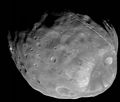Mynd:Phobos colour 2008.jpg

Stærð þessarar forskoðunar: 636 × 600 mynddílar Aðrar upplausnir: 255 × 240 mynddílar | 509 × 480 mynddílar | 815 × 768 mynddílar | 1.086 × 1.024 mynddílar | 2.172 × 2.048 mynddílar | 3.500 × 3.300 mynddílar.
Upphafleg skrá (3.500 × 3.300 mynddílar, skráarstærð: 2,72 MB, MIME-gerð: image/jpeg)
Breytingaskrá skjals
Smelltu á dagsetningu eða tímasetningu til að sjá hvernig hún leit þá út.
| Dagsetning/Tími | Smámynd | Víddir | Notandi | Athugasemd | |
|---|---|---|---|---|---|
| núverandi | 2. apríl 2018 kl. 03:10 |  | 3.500 × 3.300 (2,72 MB) | Kaldari | more margin on right side |
| 13. nóvember 2008 kl. 04:47 |  | 3.374 × 3.300 (2,7 MB) | Fir0002 | == Summary == {{Information |Description=Colour image of Phobos, imaged by the Mars Reconnaisance Orbiter in 2008 |Source=NASA |Date=9 April 2008 |Location=http://www.nasa.gov/mission_pages/MRO/multimedia/pia10368.html |Author=NASA/J |
Skráartenglar
Eftirfarandi síða notar þessa skrá:
Altæk notkun skráar
Eftirfarandi wikar nota einnig þessa skrá:
- Notkun á af.wikipedia.org
- Notkun á an.wikipedia.org
- Notkun á ar.wikipedia.org
- المريخ
- فوبوس
- قمرا المريخ
- ويكيبيديا:صور مختارة/الفضاء والكون/نظرة إلى الأعلى
- قائمة أجرام المجموعة الشمسية مرتبة حسب الحجم
- بوابة:علم الفلك/صورة مختارة
- بوابة:المريخ/مقالة مختارة/أرشيف
- بوابة:المريخ/مقالة مختارة/2
- قائمة الأقمار الطبيعية
- خط زمني لاكتشاف كواكب المجموعة الشمسية وأقمارها
- ويكيبيديا:ترشيحات الصور المختارة/القمر فوبوس
- ويكيبيديا:صورة اليوم المختارة/أغسطس 2019
- قالب:صورة اليوم المختارة/2019-08-03
- بوابة:علم الفلك/صورة مختارة/73
- معسكر قاعدة المريخ
- ويكيبيديا:صورة اليوم المختارة/يناير 2022
- قالب:صورة اليوم المختارة/2022-01-04
- Notkun á ary.wikipedia.org
- Notkun á arz.wikipedia.org
- Notkun á as.wikipedia.org
- Notkun á azb.wikipedia.org
- Notkun á az.wikipedia.org
- Notkun á be-tarask.wikipedia.org
- Notkun á be.wikipedia.org
- Notkun á bg.wikipedia.org
- Notkun á bh.wikipedia.org
- Notkun á bn.wikipedia.org
- Notkun á bn.wikibooks.org
- Notkun á bs.wikipedia.org
Skoða frekari altæka notkun þessarar skráar.





